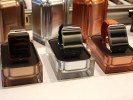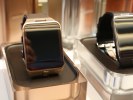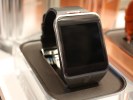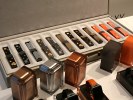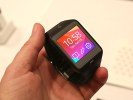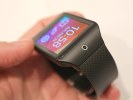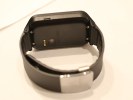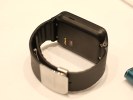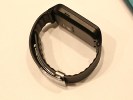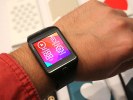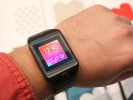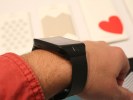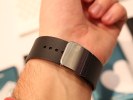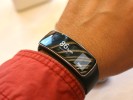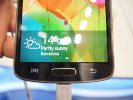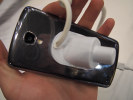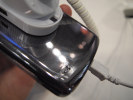Samsung Gear 2 and Gear 2 Neo hands-on
Tizen OS was thrown into the fray at the Mobile World Congress in Barcelona right away as Samsungannounced the Gear 2 and Gear 2 Neo smartwatches.
The Gear 2 and Gear 2 Neo are pretty similar devices but the Neo omits the 2MP camera, for a reduced weight of 55g. The Gear 2 will weigh 68g.
The two Tizen-powered smartwatches were unveiled at a pretty classy presentation. The Gear 2 will come in Charcoal Black, Gold Brown and Wild Orange, while the Neo will skip the Gold Brown for Mocha Grey.
Samsung Gear 2
The Gear 2 and Gear 2 Neo come with exchangeable straps in varying colors - both Samsung-made wrist straps and third-party options will be available. The smartwatch bodies themselves available in a number of paint jobs, there's plenty of potential for mixing and matching. The straps have a nice rubber texture feel to them, while the watch itself fits nicely on the wrist. The wrist strap has been stripped of controls - the camera on the Gear 2 has been moved to the body, as have the IR blaster and the microphone.
Different straps • Gear 2 Neo
The Gear 2 and Gear 2 Neo have a 300mAh battery (as opposed to the 315mAh unit on the Galaxy Gear) and promise 2 - 3 days of standby time with regular usage, up to 6 days of if used sparingly. The touchscreen is the same 1.63" AMOLED unit while the dual-core processor has seen a slight bump in clockspeed from 800MHz to 1GHz. There's 512MB of RAM and 4 gigs of internal storage.
Both watches are IP67-certified for dust and water resistance.
Wrist strap sans the 2 MP camera
This year's Gear lineup will feature a heart-rate monitor and a fitness app, while the IR port will allow remote control of various appliances. There will also be a music player on board.
Samsung Gear 2 Neo on hand
The smartwatches are less dependent on their smartphone counterparts. With things like a built-in music player and a stand-alone fitness app, users can go about their exercise routine without carrying a smartphone.
Samsung Gear Fit
In addition to the Galaxy Gear 2 duo of smartwatches, Samsung also unveiled a strictly fitness oriented wristband, called simply the Gear Fit.
The Samsung Gear Fit features a 1.84" curved Super AMOLED display with a resolution of 432 x 128 pixels. It may not sound like much, but the pixel density is quite high at 244 pixels per inch. The colors really pop, as you'd expect from a Super AMOLED display and the contrast is great. We're also happy to report that the viewing angles are also great.
One of the Gear Fit's cornerstone features is its heart rate monitor. It is mounted on the back of the wristband and after a short adjusting displays your heart rate. It works seamlessly and will be helpful for those who want to keep an eye on their vitals.
The Samsung Fit live photos
The Galaxy Fit packs a 210mAh battery, which may not sound like much, but it's capable of a maximum usage time of 7 days. With a standard usage, Samsung says the Fit's battery will manage 3-4 days, and that's not too bad.
Inside the Fit also reside an accelerometer and a gyroscope, which will undoubtedly enable developers to come up with some really nifty apps. Bluetooth 4.0 LE handles the connection with your smartphone.
Next to the heart rate monitor at the bottom of the Fit sit the pin connectors used for charging the battery.
The Fit is quite comfortable
The weight of the wristband is just 27 grams and it measures 23.4 x 57.4 x 11.95mm. It's also water- and dust-resistant as it is IP67 certified. The straps are changeable and Samsung offers a variety of others for you to choose from.
Running Tizen, the Fit can display notifications from your smartphones such as calls, emails, SMS messages and notifications from apps. It's also capable of controlling your music and can help you schedule new appointments. Additionally, it packs a timer and a stopwatch.
Samsung Tizen prototype hands-on
Tizen did have a presence at the MWC as promised, but that was in the form of the new Galaxy Gear watches. The only Tizen-running phone we saw was a prototype device that looks a lot like a Galaxy S4. Samsung made it clear it's not an S4 and is for development purposes only, it won't be selling it.
Never mind the actual device, this is our first look of Tizen OS on a phone (odd, considering the OS is on version 3.0 already). The interface looks very much like Samsung's latest iteration of TouchWiz running on Android 4.4 KitKat, but simplified. We found it very comfortable to use.
There are some differences - for example, widgets on the homescreen feel more like Windows Phone live tiles than Android widgets. Also, the homescreen itself has two modes - Basic and Office. Both options have two separate sets of homescreen panes for good work/personal life separation.
Tizen feels similar to TouchWizzified Android • Basic and Office home screens
Some familiar TouchWiz features like the floating mini apps are available here too. There are widgets on the homescreen, but they felt more like live tiles than Android widgets. Most of them were 1x1 though, bigger widgets were rare.
Mini apps
As for the device Tizen was running on, it's clear the hardware was based on the Galaxy S4. Unfortunately for Bada fans, or is it Maemo and MeeGo fans (those branches merged to form Tizen), Samsung won't be selling this device. There are no official plans to sell any Tizen phone yet.
The prototype was probably based on Galaxy S4




